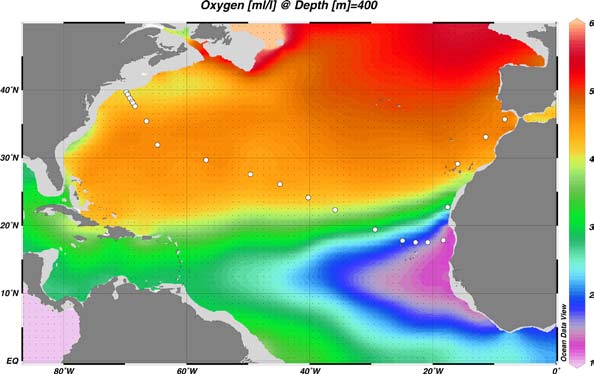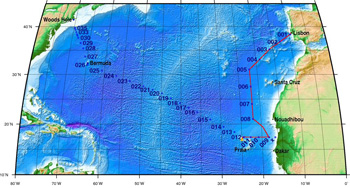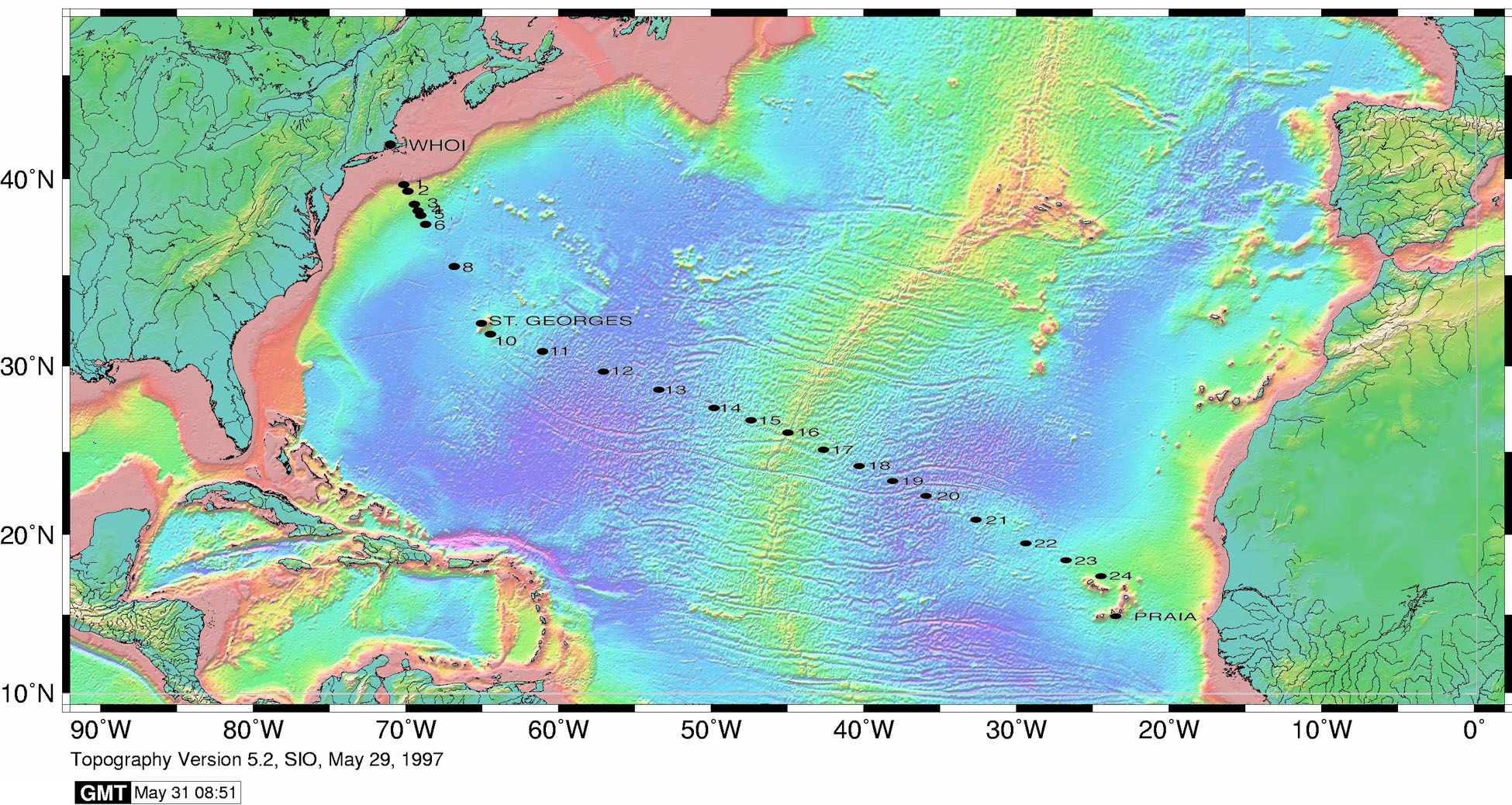Dissolved Iron, Manganese, Zinc, Cadmium and Copper concentrations from R/V Knorr KN199-04, KN204-01 in the subtropical northern Atlantic Ocean from 2010-2011 (U.S. GEOTRACES NAT project)
Project
Program
| Contributors | Affiliation | Role |
|---|---|---|
| Wu, Jingfeng | University of Miami Rosenstiel School of Marine and Atmospheric Science (UM-RSMAS) | Principal Investigator |
| Allison, Dicky | Woods Hole Oceanographic Institution (WHOI BCO-DMO) | BCO-DMO Data Manager |
Abstract
Dissolved and dissolvable Fe, Mn, Zn, Cd and Cu concentrations from GeoTraces Go-Flo rosette casts analyzed by isotope dilution using Inductively Coupled Plasma Mass Spectrometry. Samples were collected at sea and analyzed later ashore.
NOTE: These Data were unrestricted when the GEOTRACES Intermediate Data Product was published by BODC.
Sampling: Seawater samples for dissolved Fe, Mn, Zn, Cu and Cd analysis were collected using GEOTRACES trace metal clean sampler (Teflon coated Go-Flo Bottles attached to non-metallic rosette). The collected samples were passed through 0.4 micrometer diameter pore filter membrane before acidification by adding 2.8 ml triple distilled HCl per liter sample. The acidified samples were stored in acid washed low density polyethylene bottles at room temperature for more than 3 months before analysis.
Analytical Methods: Dissolved Fe, Zn, Cu and Cd in the seawater samples were analyzed using Mg(OH)2 coprecipitation ID-ICPMS (isotope dilution - Inductively Coupled Plasma Mass Spectrometry) (Wu and Boyle, 1997; 1998). Dissolved Mn was measured using the same method modified by Boyle et al (2005). The precision and analytical blanks vary for each station and are provided together with each profile in the submitted file.
References: Wu J. and Boyle E. A. (1997) Low blank preconcentration technique for the determination of lead, copper, and cadmium in small-volume seawater samples by isotope dilution ICPMS. Anal. Chem. 69, 2464-2470.
Wu J. and Boyle E. A. (1998) Determination of iron in seawater by isotope dilution inductively couple plasma mass spectrometry after Mg(OH)2 coprecipitation. Anal. Chim. Acta 367, 183-191.
Boyle E. A., Bergquist R. A., Hayser R. A. and Mahowald N. (2005) Iron, manganese, and lead at Hawaii ocean time-series station ALOHA: temporal variability in an intermediate water hydrothermal plume. Geochim. Cosmochim. Acta 69, 933-952.
BCO-DMO edits:
- Depth and Pressure occupied the 'Depth(m)' column. To be consistent, where necessary corrected to Depth in meters. (information from GT-C Bottle file)
- Cadmium concentration reported in both nM and pM. PI said change to pM.
- Cadmium concentration was displayed without decimal precision when submitted, although the Excel cells had 16 decimals of precision. DMO changed to two decimal places to be consistent with other Cd submitted. Submitted Cd blanks have zero to two decimals.
- Two portions of KN204-01, KN204-01A and KN204-01B, were reported as 'cruise_part'.
- Station nominal locations were provided by Chief Scientists because casts were not all in the same place as the original station location. This dataset had no cast information.
- 'nd's put in blank cells.
- KN199-04:
station 7 depth changed to 751 from 757
station 10 depth changed to 800 from 780
station 12 Wu depths were Measures' pressure, so I changed the numbers to match Measures depths, according to instructions from the PI.
| File |
|---|
Fe-Zn-Mn-Cd-Cu_GT10-11.csv (Comma Separated Values (.csv), 124.97 KB) MD5:e87769f4b188f054cd990dcbfe504c90 Primary data file for dataset ID 3861 |
| Parameter | Description | Units |
| cruise_name | local cruise name | dimensionless |
| cruise_id | cruise ID number | alphanumeric |
| station | station number within cruise | integer |
| lat_chsci | latitude provided by Chief Scientist - this is the nominal location of the data. For all lats north is positive. | decimal degrees |
| lon_chsci | longitude provided by Chief Scientist - this is the nominal location of the data - theoretically these were the station locations given to the bridge. For all Lons west is negative. | decimal degrees |
| lat_nom | when Chief Scientist was unable to provide the station list given to the bridge the locations of all the casts for this station were averaged and this is the mean latitude | decimal degrees |
| lon_nom | see lat_nom | decimal degrees |
| depth | depth the data were collected | meters |
| Fe_average | average dissolved Iron concentration. Average of replicates. | nanoMoles |
| Fe_stdev | standard deviation of dissolved iron concentration | nanoMoles |
| Fe_blank | Iron concentration blank | nanoMoles |
| Fe_blank_uncert | uncertainty in iron blank -- reported as blank plus or minus this number | nanoMoles |
| Fe_flag | quality flag for the iron data - not a number - questionable or good. | alphanumeric |
| Fe_n | number of replicates | integer |
| Zn_average | average dissolved Zinc concentration. Average of replicates. | nanoMoles |
| Zn_stdev | standard deviation of dissolved zinc concentration | nanoMoles |
| Zn_blank | Zinc concentration blank | nanoMoles |
| Zn_blank_uncert | uncertainty in zinc blank -- reported as blank plus or minus this number | nanoMoles |
| Zn_flag | quality flag for the zinc data - not a number - questionable or good. | alphanumeric |
| Zn_n | number of replicates | integer |
| Mn_average | average dissolved Manganese concentration. Average of replicates. | nanoMoles |
| Mn_stdev | standard deviation of dissolved manganese concentration | nanoMoles |
| Mn_blank | Manganese concentration blank | nanoMoles |
| Mn_blank_uncert | uncertainty in manganese blank -- reported as blank plus or minus this number | nanoMoles |
| Mn_flag | quality flag for the manganese data - not a number - questionable or good. | alphanumeric |
| Mn_n | number of replicates | integer |
| Cd_average | average dissolved Cadmium concentration. Average of replicates. | picoMoles |
| Cd_stdev | standard deviation of dissolved cadmium concentration | picoMoles |
| Cd_blank | Cadmium concentration blank | picoMoles |
| Cd_blank_uncert | uncertainty in cadmium blank -- reported as blank plus or minus this number | picoMoles |
| Cd_flag | quality flag for the cadmium data - not a number - questionable or good. | alphanumeric |
| Cd_n | number of replicates | integer |
| Cu_average | average dissolved Copper concentration. Average of replicates. | nanoMoles |
| Cu_stdev | standard deviation of dissolved copper concentration | nanoMoles |
| Cu_blank | Copper concentration blank | nanoMoles |
| Cu_blank_uncert | uncertainty in copper blank -- reported as blank plus or minus this number | nanoMoles |
| Cu_flag | quality flag for the copper data - not a number - questionable or good. | alphanumeric |
| Cu_n | number of replicates | integer |
| cruise_part | KN204-01A or KN204-01B | alphanumeric |
| lat | PI supplied lat - probably first cast latitude. North is positive. | decimal degrees |
| lon | PI supplied lon - probably first cast longitude. West is negative | decimal degrees |
| sample_GEOTRC | GEOTRACES sample number. | none |
| Dataset-specific Instrument Name | GO-FLO Teflon Trace Metal |
| Generic Instrument Name | GO-FLO Teflon Trace Metal Bottle |
| Dataset-specific Description | Teflon coated Go-Flo bottles attached to non-metallic rosette. |
| Generic Instrument Description | GO-FLO Teflon-lined Trace Metal free sampling bottles are used for collecting water samples for trace metal, nutrient and pigment analysis. The GO-FLO sampling bottle is designed specifically to avoid sample contamination at the surface, internal spring contamination, loss of sample on deck (internal seals), and exchange of water from different depths. |
| Dataset-specific Instrument Name | Isotope dilution -Inductively Coupled Plasma Mass Spectrometer |
| Generic Instrument Name | Inductively Coupled Plasma Mass Spectrometer |
| Dataset-specific Description | ID-ICPMS |
| Generic Instrument Description | An ICP Mass Spec is an instrument that passes nebulized samples into an inductively-coupled gas plasma (8-10000 K) where they are atomized and ionized. Ions of specific mass-to-charge ratios are quantified in a quadrupole mass spectrometer. |
KN199-04
| Website | |
| Platform | R/V Knorr |
| Report | |
| Start Date | 2010-10-15 |
| End Date | 2010-11-04 |
| Description | This cruise constitutes the first survey section as part of the U.S. participation in an international program named GEOTRACES.
Funding: NSF OCE award 0926423
Science Objectives: To obtain state of the art trace metal and isotope measurements on a suite of samples taken on a mid-latitude zonal transect of the North Atlantic. In particular, sampling targeted the oxygen minimum zone extending off the west African coast near Mauritania, the TAG hydrothermal field, and the western boundary current system along Line W. For additional information, please refer to the GEOTRACES program Web site (https://www.geotraces.org/) for overall program objectives and a summary of properties measured.
Science Activities include seawater sampling via GoFLO and Niskin carousels, in situ pumping (and filtration), CTDO2 and transmissometer sensors, underway pumped sampling of surface waters, and collection of aerosols and rain. Hydrography, CTD and nutrient measurements were supported by the Ocean Data Facility (J. Swift) at Scripps Institution of Oceanography and funded through NSF Facilities. They provided an additional CTD rosette system along with nephelometer and LADCP. A trace metal clean Go-Flo Rosette and winch were provided by the group at Old Dominion University (G. Cutter) along with a towed underway pumping system.
Additional cruise information is available from the Rolling Deck to Repository (R2R): https://www.rvdata.us/search/cruise/KN199-04
Other Relevant Links:
List of cruise participants: [ PDF ]
Cruise track: JPEG image (from Woods Hole Oceanographic Institution, vessel operator)
ADCP data are available from the Currents ADCP group at the University of Hawaii: KN199-04 ADCP |
KN204-01
| Website | |
| Platform | R/V Knorr |
| Report | |
| Start Date | 2011-11-06 |
| End Date | 2011-12-11 |
| Description | The US GEOTRACES North Atlantic cruise aboard the R/V Knorr completed the section between Lisbon and Woods Hole that began in October 2010 but was rescheduled for November-December 2011. The R/V Knorr made a brief stop in Bermuda to exchange samples and personnel before continuing across the basin. Scientists disembarked in Praia, Cape Verde, on 11 December. The cruise was identified as KN204-01A (first part before Bermuda) and KN204-01B (after the Bermuda stop). However, the official deployment name for this cruise is KN204-01 and includes both part A and B.
Science activities included: ODF 30 liter rosette CTD casts, ODU Trace metal rosette CTD casts, McLane particulate pump casts, underway sampling with towed fish and sampling from the shipboard "uncontaminated" flow-through system.
Full depth stations are shown in the accompanying figure (see below). Additional stations to sample for selected trace metals to a depth of 1000 m are not shown. Standard stations are shown in red (as are the ports) and "super" stations, with extra casts to provide large-volume samples for selected parameters, are shown in green.
Station spacing is concentrated along the western margin to evaluate the transport of trace elements and isotopes by western boundary currents. Stations across the gyre will allow scientists to examine trace element supply by Saharan dust, while also contrasting trace element and isotope distributions in the oligotrophic gyre with conditions near biologically productive ocean margins, both in the west, to be sampled now, and within the eastern boundary upwelling system off Mauritania, sampled last year.
Funding: The cruise was funded by NSF OCE awards 0926204, 0926433 and 0926659.
Additional cruise information is available from the Rolling Deck to Repository (R2R): https://www.rvdata.us/search/cruise/KN204-01
Other Relevant Links:
ADCP data are available from the Currents ADCP group at the University of Hawaii at the links below:
KN204-01A (part 1 of 2011 cruise; Woods Hole, MA to Bermuda)
KN204-01B (part 2 of 2011 cruise; Bermuda to Cape Verde) |
U.S. GEOTRACES North Atlantic Transect (GA03) (U.S. GEOTRACES NAT)
Much of this text appeared in an article published in OCB News, October 2008, by the OCB Project Office.
The first U.S. GEOTRACES Atlantic Section will be specifically centered around a sampling cruise to be carried out in the North Atlantic in 2010. Ed Boyle (MIT) and Bill Jenkins (WHOI) organized a three-day planning workshop that was held September 22-24, 2008 at the Woods Hole Oceanographic Institution. The main goal of the workshop, sponsored by the National Science Foundation and the U.S. GEOTRACES Scientific Steering Committee, was to design the implementation plan for the first U.S. GEOTRACES Atlantic Section. The primary cruise design motivation was to improve knowledge of the sources, sinks and internal cycling of Trace Elements and their Isotopes (TEIs) by studying their distributions along a section in the North Atlantic (Figure 1). The North Atlantic has the full suite of processes that affect TEIs, including strong meridional advection, boundary scavenging and source effects, aeolian deposition, and the salty Mediterranean Outflow. The North Atlantic is particularly important as it lies at the "origin" of the global Meridional Overturning Circulation.
It is well understood that many trace metals play important roles in biogeochemical processes and the carbon cycle, yet very little is known about their large-scale distributions and the regional scale processes that affect them. Recent advances in sampling and analytical techniques, along with advances in our understanding of their roles in enzymatic and catalytic processes in the open ocean provide a natural opportunity to make substantial advances in our understanding of these important elements. Moreover, we are motivated by the prospect of global change and the need to understand the present and future workings of the ocean's biogeochemistry. The GEOTRACES strategy is to measure a broad suite of TEIs to constrain the critical biogeochemical processes that influence their distributions. In addition to these "exotic" substances, more traditional properties, including macronutrients (at micromolar and nanomolar levels), CTD, bio-optical parameters, and carbon system characteristics will be measured. The cruise starts at Line W, a repeat hydrographic section southeast of Cape Cod, extends to Bermuda and subsequently through the North Atlantic oligotrophic subtropical gyre, then transects into the African coast in the northern limb of the coastal upwelling region. From there, the cruise goes northward into the Mediterranean outflow. The station locations shown on the map are for the "fulldepth TEI" stations, and constitute approximately half of the stations to be ultimately occupied.
Figure 1. The proposed 2010 Atlantic GEOTRACES cruise track plotted on dissolved oxygen at 400 m depth. Data from the World Ocean Atlas (Levitus et al., 2005) were plotted using Ocean Data View (courtesy Reiner Schlitzer). [click on the image to view a larger version]

Hydrography, CTD and nutrient measurements will be supported by the Ocean Data Facility (J. Swift) at Scripps Institution of Oceanography and funded through NSF Facilities. They will be providing an additional CTD rosette system along with nephelometer and LADCP. A trace metal clean Go-Flo Rosette and winch will be provided by the group at Old Dominion University (G. Cutter) along with a towed underway pumping system.
The North Atlantic Transect cruise began in 2010 with KN199 leg 4 (station sampling) and leg 5 (underway sampling only) (Figure 2).
Figure 2. The red line shows the cruise track for the first leg of the US Geotraces North Atlantic Transect on the R/V Knorr in October 2010. The rest of the stations (beginning with 13) will be completed in October-December 2011 on the R/V Knorr (courtesy of Bill Jenkins, Chief Scientist, GNAT first leg). [click on the image to view a larger version]

The section completion effort resumed again in November 2011 with KN204-01A,B (Figure 3).
KN204-01A,B Cruise Report (PDF)
Figure 3. Station locations occupied on the US Geotraces North Atlantic Transect on the R/V Knorr in November 2011. [click on the image to view a larger version]

Data from the North Atlantic Transect cruises are available under the Datasets heading below, and consensus values for the SAFe and North Atlantic GEOTRACES Reference Seawater Samples are available from the GEOTRACES Program Office: Standards and Reference Materials
ADCP data are available from the Currents ADCP group at the University of Hawaii at the links below:
KN199-04 (leg 1 of 2010 cruise; Lisbon to Cape Verde)
KN199-05 (leg 2 of 2010 cruise; Cape Verde to Charleston, NC)
KN204-01A (part 1 of 2011 cruise; Woods Hole, MA to Bermuda)
KN204-01B (part 2 of 2011 cruise; Bermuda to Cape Verde)
U.S. GEOTRACES (U.S. GEOTRACES)
GEOTRACES is a SCOR sponsored program; and funding for program infrastructure development is provided by the U.S. National Science Foundation.
GEOTRACES gained momentum following a special symposium, S02: Biogeochemical cycling of trace elements and isotopes in the ocean and applications to constrain contemporary marine processes (GEOSECS II), at a 2003 Goldschmidt meeting convened in Japan. The GEOSECS II acronym referred to the Geochemical Ocean Section Studies To determine full water column distributions of selected trace elements and isotopes, including their concentration, chemical speciation, and physical form, along a sufficient number of sections in each ocean basin to establish the principal relationships between these distributions and with more traditional hydrographic parameters;
* To evaluate the sources, sinks, and internal cycling of these species and thereby characterize more completely the physical, chemical and biological processes regulating their distributions, and the sensitivity of these processes to global change; and
* To understand the processes that control the concentrations of geochemical species used for proxies of the past environment, both in the water column and in the substrates that reflect the water column.
GEOTRACES will be global in scope, consisting of ocean sections complemented by regional process studies. Sections and process studies will combine fieldwork, laboratory experiments and modelling. Beyond realizing the scientific objectives identified above, a natural outcome of this work will be to build a community of marine scientists who understand the processes regulating trace element cycles sufficiently well to exploit this knowledge reliably in future interdisciplinary studies.
Expand "Projects" below for information about and data resulting from individual US GEOTRACES research projects.
| Funding Source | Award |
|---|---|
| NSF Division of Ocean Sciences (NSF OCE) |
[ table of contents | back to top ]